High-Q-Factor Silica-Based Racetrack Microring Resonators
Abstract
1. Introduction
2. Device Design and Simulation
3. Device Fabrication and Characterization
4. Discussion
5. Conclusions
Author Contributions
Funding
Institutional Review Board Statement
Informed Consent Statement
Data Availability Statement
Conflicts of Interest
References
- Huynh, T.N.; Carroll, J.O.; Smyth, F.; Shi, K.; Nguyen, L.; Anandarajah, P.; Phelan, R.; Kelly, B.; Barry, L.P. Low linewidth lasers for enabling high-capacity optical communication systems. In Proceedings of the 2012 14th International Conference on Transparent Optical Networks (ICTON), Coventry, UK, 2–5 July 2012. [Google Scholar]
- Kita, T.; Tang, R.; Yamada, H. Narrow Spectral Linewidth Silicon Photonic Wavelength Tunable Laser Diode for Digital Coherent Communication System. IEEE J. Sel. Top. Quantum Electron. 2016, 22, 1500612. [Google Scholar] [CrossRef]
- Matsui, Y.; Eriksson, U.; Wesstrom, J.-O.; Liu, Y.T.; Hammerfeldt, S.; Hassler, M.; Stoltz, B.; Carlsson, N.; Siraj, S.; Goobar, E. Narrow linewidth tunable semiconductor laser. In Proceedings of the 2016 Compound Semiconductor Week (CSW) Includes 28th International Conference on Indium Phosphide & Related Materials (IPRM) & 43rd International Symposium on Compound Semiconductors (ISCS), Toyama, Japan, 26–30 June 2016. [Google Scholar]
- Shin, D.-K.; Henson, B.-M.; Khakimov, R.-I.; Ross, J.-A.; Dedman, C.-J.; Hodgman, S.-S.; Baldwin, K.-T.-H.; Truscott, A.-G. Widely tunable, narrow linewidth external-cavity gain chip laser for spectroscopy between 1.0–1.1 microm. Opt. Express 2016, 24, 27403–27414. [Google Scholar] [CrossRef] [PubMed]
- Wicht, A.; Bawamia, A.; Krüger, M.; Kürbis, C.; Schiemangk, M.; Smol, R.; Peters, A.; Tränkle, G. Narrow linewidth diode laser modules for quantum optical sensor applications in the field and in space. In Proceedings of the Components and Packaging for Laser Systems III, San Francisco, CA, USA, 27 February 2017. [Google Scholar]
- Stolpner, L.; Lee, S.; Li, S.; Mehnert, A.; Mols, P.; Siala, S. Low noise planar external cavity laser for interferometric fiber optic sensors. In Proceedings of the 19th International Conference on Optical Fibre Sensors, Perth, WA, Australia, 16 May 2008. [Google Scholar]
- Zhang, M.; Lu, M.; Ge, C.; Cunningham, T. Plasmonic external cavity laser refractometric sensor. Opt. Express 2014, 22, 20347–20357. [Google Scholar] [CrossRef]
- Signoret, P.; Myara, M.; Tourrenc, J.-P.; Orsal, B.; Monier, M.-H.; Jacquet, J.; Leboudec, P.; Marin, F. Bragg Section Effects on Linewidth and Lineshape in 1.55 μm DBR Tunable Laser Diodes. IEEE Photonics Technol. Lett. 2004, 16, 1429–1431. [Google Scholar] [CrossRef]
- Faugeron, M.; Tran, M.; Parillaud, O.; Chtioui, M.; Robert, Y.; Vinet, E.; Enard, A.; Jacquet, J.; Dijk, F.-V. High-Power Tunable Dilute Mode DFB Laser With Low RIN and Narrow Linewidth. IEEE Photonics Technol. Lett. 2013, 25, 7–10. [Google Scholar] [CrossRef]
- Ren, M.; Cai, H.; Chin, L.K.; Radhakrishnan, K.; Gu, Y.D.; Lo, G.Q.; Kwong, D.L.; Liu, A.Q. Coupled-ring reflector in an external-cavity tunable laser. Optica 2015, 2, 940–943. [Google Scholar] [CrossRef]
- Lin, S.Y.; Djordjevic, S.-S.; Cunningham, J.-E.; Shubin, I.; Luo, Y.; Yao, J.; Li, G.L.; Thacker, H.; Lee, J.H.; Raj, K.; et al. Vertical-coupled high-efficiency tunable III-V- CMOS SOI hybrid external-cavity laser. Opt. Express 2013, 21, 32425–32431. [Google Scholar] [CrossRef]
- Kobayashi, N.; Sato, K.; Namiwaka, M.; Yamamoto, K.; Watanabe, S.; Kita, T.; Yamada, H.; Yamazaki, H. Silicon Photonic Hybrid Ring-Filter External Cavity Wavelength Tunable Lasers. J. Lightwave Technol. 2015, 33, 1241–1246. [Google Scholar] [CrossRef]
- Zhu, Y.Y.; Zhu, L. Narrow-linewidth, tunable external cavity dual-band diode lasers through InP/GaAs-Si3N4 hybrid integration. Opt. Express 2019, 27, 2354–2362. [Google Scholar] [CrossRef]
- Yoon, K.; Kwon, O.; Kim, K.; Choi, B.; Oh, S.H.; Kim, H.S.; Sim, J.S.; Kim, C.S. Ring-resonator-integrated tunable external cavity laser employing EAM and SOA. Opt. Express 2011, 19, 25465–25470. [Google Scholar] [CrossRef]
- Choi, B.-S.; Jeong, J.S.; Lee, H.K.; Chung, Y.C. Simple detuning method for low-chirp operation in polymer-based tunable external-cavity lasers. Opt. Express 2015, 23, 251414. [Google Scholar] [CrossRef] [PubMed]
- Felipe, D.-D.; Zhang, Z.Y.; Brinker, W.; Kleinert, M.; Novo, A.-M.; Zawadzki, C.; Moehrle, M.; Keil, N. Polymer-Based External Cavity Lasers: Tuning Efficiency, Reliability, and Polarization Diversity. IEEE Photonics Technol. Lett. 2014, 26, 1391–1394. [Google Scholar] [CrossRef]
- Wang, L.; An, J.; Wu, Y.; Zhang, J.; Wang, Y.; Li, J.; Wang, H.; Zhang, X.; Pan, P.; Zhang, L.; et al. A compact and low-loss 1×8 optical power splitter using silica-based PLC on quartz substrate. Opt. Commun. 2014, 312, 203–209. [Google Scholar] [CrossRef]
- Li, C.; An, J.; Zhang, J.; Wang, L.; Li, J.; Wang, Y.; Yin, X.; Wang, H.; Wu, Y. 4 × 20 GHz silica-based AWG hybrid integrated receiver optical sub-assemblies. Chin. Opt. Lett. 2018, 16, 060603. [Google Scholar]
- Liu, D.; Sun, S.; Yin, X.; Sun, B.; Sun, J.; Liu, Y.; Li, W.; Zhu, N.; Li, M. Large-capacity and low-loss integrated optical buffer. Opt. Express 2019, 27, 11585–11593. [Google Scholar] [CrossRef]
- Tian, Z.B.; Veerasubramanian, V.; Bianucci, P.; Bianucci, P.; Mukherjee, S.; Mi, Z.; Kirk, A.G.; Plant, D.V. Single rolled-up InGaAs/GaAs quantum dot microtubes integrated with silicon-on-insulator waveguides. Opt. Express 2011, 19, 12164–12171. [Google Scholar] [CrossRef]
- Tu, X.; Chen, S.-L.; Song, C.-L.; Huang, T.-Y.; Guo, L.J. Ultrahigh Q Polymer Microring Resonators for Bionsensing Applications. IEEE Photonics J. 2019, 11, 4200110. [Google Scholar] [CrossRef]
- Girault, P.; Lorrain, N.; Lemaitre, J.; Poffo, L.; Guendouz, M.; Hardy, I.; Gadonna, M.; Gutierrez, A.; Bodiou, L.; Charrier, J. Racetrack micro-resonators based on ridge waveguides made of porous silica. Opt. Mater. 2015, 50, 167–174. [Google Scholar] [CrossRef]
- Girault, P.; Lorrain, N.; Poffo, L.; Guendouz, M.; Lemaitre, J.; Carre, C.; Gadonna, M.; Bosc, D.; Vignaud, G. Integrated polymer micro-ring resonators for optical sensing applications. J. Appl. Phys. 2015, 117, 104504. [Google Scholar] [CrossRef]
- Westerveld, W.J.; Pozo, J.; Harmsma, P.J.; Schmits, R.; Tabak, E.; van den Dool, T.C.; Leinders, S.M.; van Dongen, K.W.A.; Paul Urbach, H.P.; Yousefi, M. Characterization of a photonic strain sensor in silicon-on-insulator technology. Opt. Lett. 2012, 37, 479–481. [Google Scholar] [CrossRef][Green Version]
- Lv, H.-L.; Liang, Y.-X.; Wu, Z.-L.; Han, X.-Y.; Morthier, G.; Zhao, M.-S. Polymer-Based Microring Resonator with the Multimode Interference Coupler Operating at Very-Near-Infrared Wavelengths. Appl. Sci. 2019, 9, 2715. [Google Scholar] [CrossRef]
- Madani, A.; Bottner, S.; Jorgensen, M.R.; Schmidt, O.G. Rolled-up TiO2 optical microcavities for telecom and visible photonics. Opt. Lett. 2014, 39, 189–192. [Google Scholar] [CrossRef] [PubMed]
- Zhang, L.; Zhao, H.Y.; Wang, H.Y.; Shao, S.Z.; Tian, W.J.; Ding, J.F.; Fu, X.; Yang, L. Cascading Second-Order Microring Resonators for a Box-Like Filter Response. J. Lightwave Technol. 2017, 35, 5347–5360. [Google Scholar] [CrossRef]
- Xu, L.; Hou, J.; Tang, H.T.; Yu, Y.; Yu, Y.; Shu, X.W.; Zhang, X.L. Silicon-on-insulator-based microwave photonic filter with widely adjustable bandwidth. Photonics Res. 2019, 7, 110–115. [Google Scholar] [CrossRef]
- Ma, C.-S.; Zhang, H.-M.; Zhang, D.-M.; Cui, Z.-C.; Liu, S.-Y. Effects of trapezoid core cross-sections on transmission characteristics of polymer arrayed waveguide grating multiplexers. Opt. Commun. 2004, 241, 321–331. [Google Scholar] [CrossRef]
- Ma, C.-S.; Xu, Y.-Z.; Yan, X.; Qin, Z.-K.; Wang, X.-Y. Optimization and analysis of series-coupled microring resonator arrays. Opt. Commun. 2006, 262, 41–46. [Google Scholar] [CrossRef]
- Rabus, D.G. Integrated Ring Resonators; Springer: Berlin/Heidelberg, Germany, 2007; pp. 3–6. [Google Scholar]
- Griffith, A.; Cardenas, J.; Poitras, C.-B.; Lipson, M. High quality factor and high confinement silicon resonators using etchless process. Opt. Express 2012, 20, 21341–21345. [Google Scholar] [CrossRef]
- Ji, X.-C.; Barbosa, F.-A.-S.; Roberts, S.-P.; Dutt, A.; Cardenas, J.; Okawachi, Y.; Bryant, A.; Gaeta, L.; Lipson, M. Ultra-low-loss on-chip resonators with sub-milliwatt parametric oscillation threshold. Optica 2017, 4, 619–624. [Google Scholar] [CrossRef]
- Zhang, L.; Jie, L.-L.; Zhang, M.; Wang, Y.; Xie, Y.-W.; Shi, Y.-C.; Dai, D.-X. Ultrahigh-Q silicon racetrack resonators. Photonics Res. 2020, 8, 684–689. [Google Scholar] [CrossRef]
- Guillén-Torres, M.-A.; Caverley, M.; Cretu, E.; Jaeger, N.-A.-F.; Chrostowski, L. Large-Area, High-Q SOI Ring Resonators. In Proceedings of the 2014 IEEE Photonics Conference, San Diego, CA, USA, 12–16 October 2014. [Google Scholar]
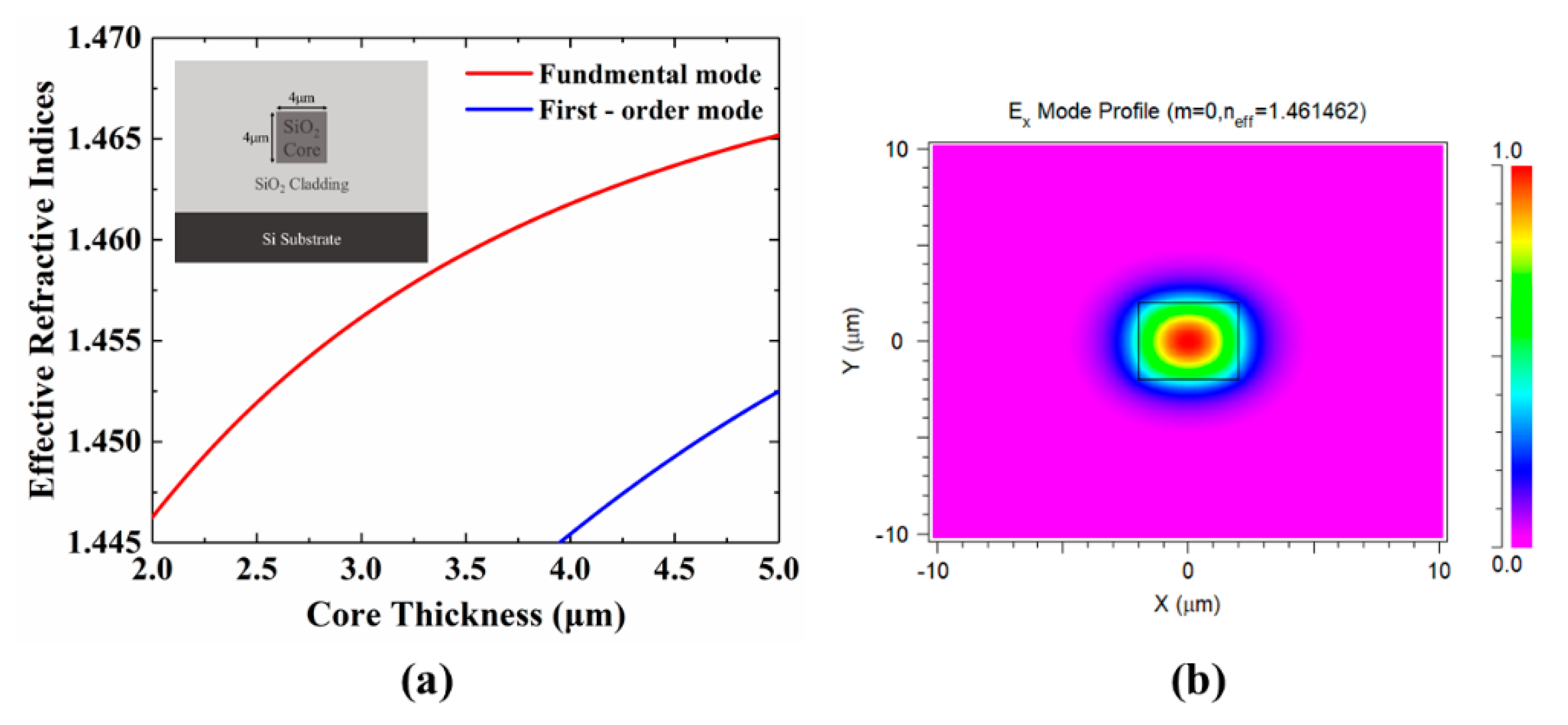
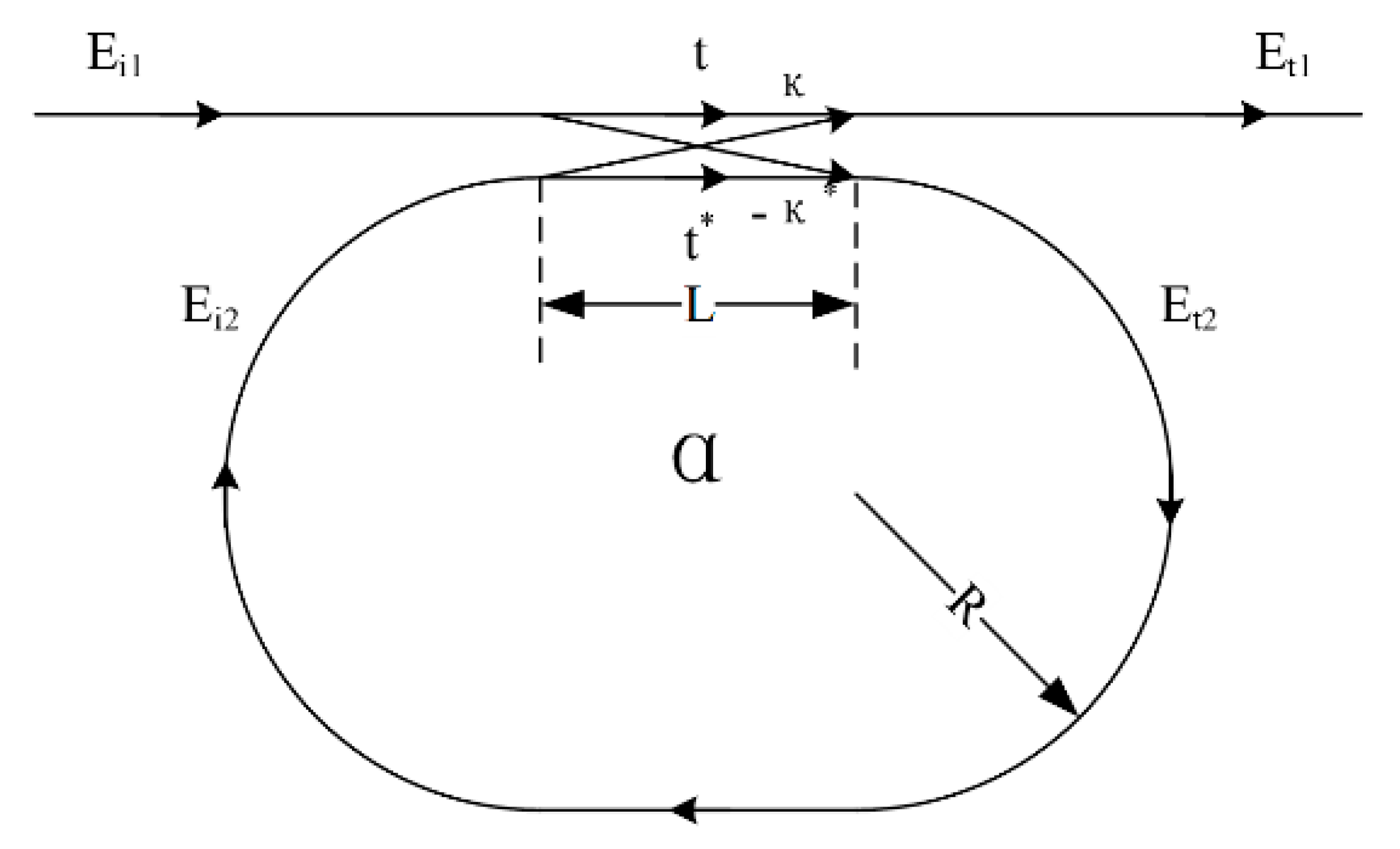
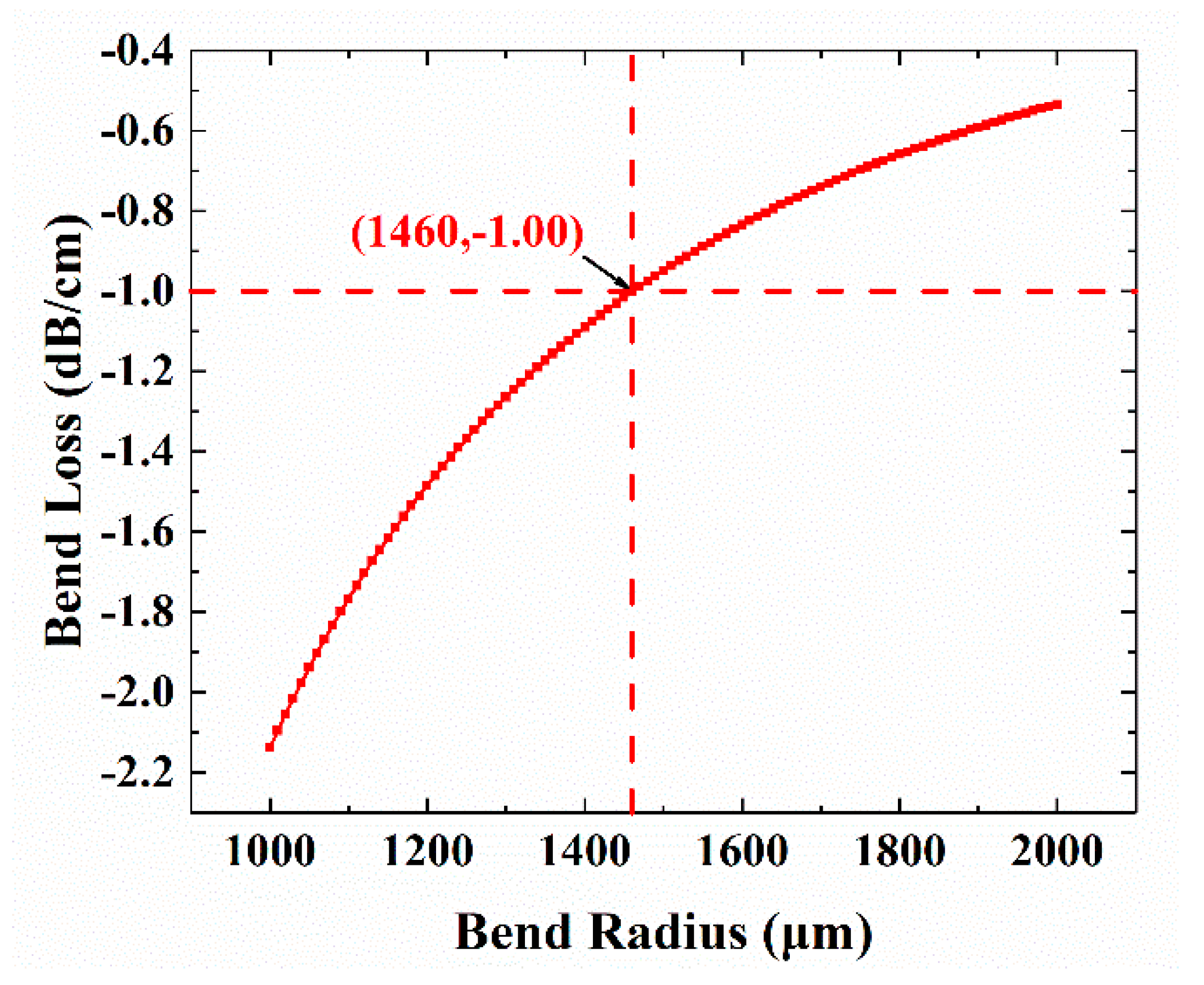
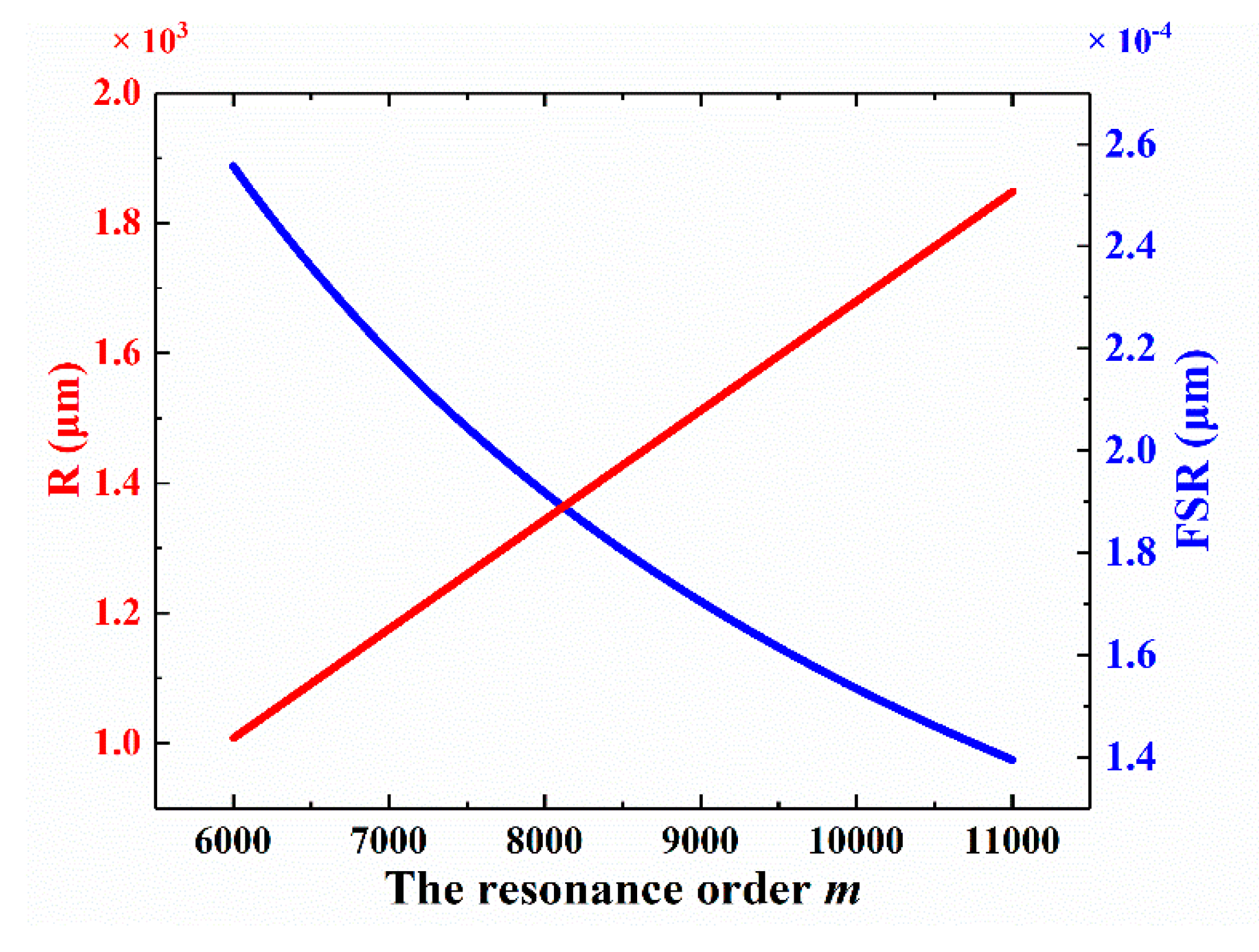
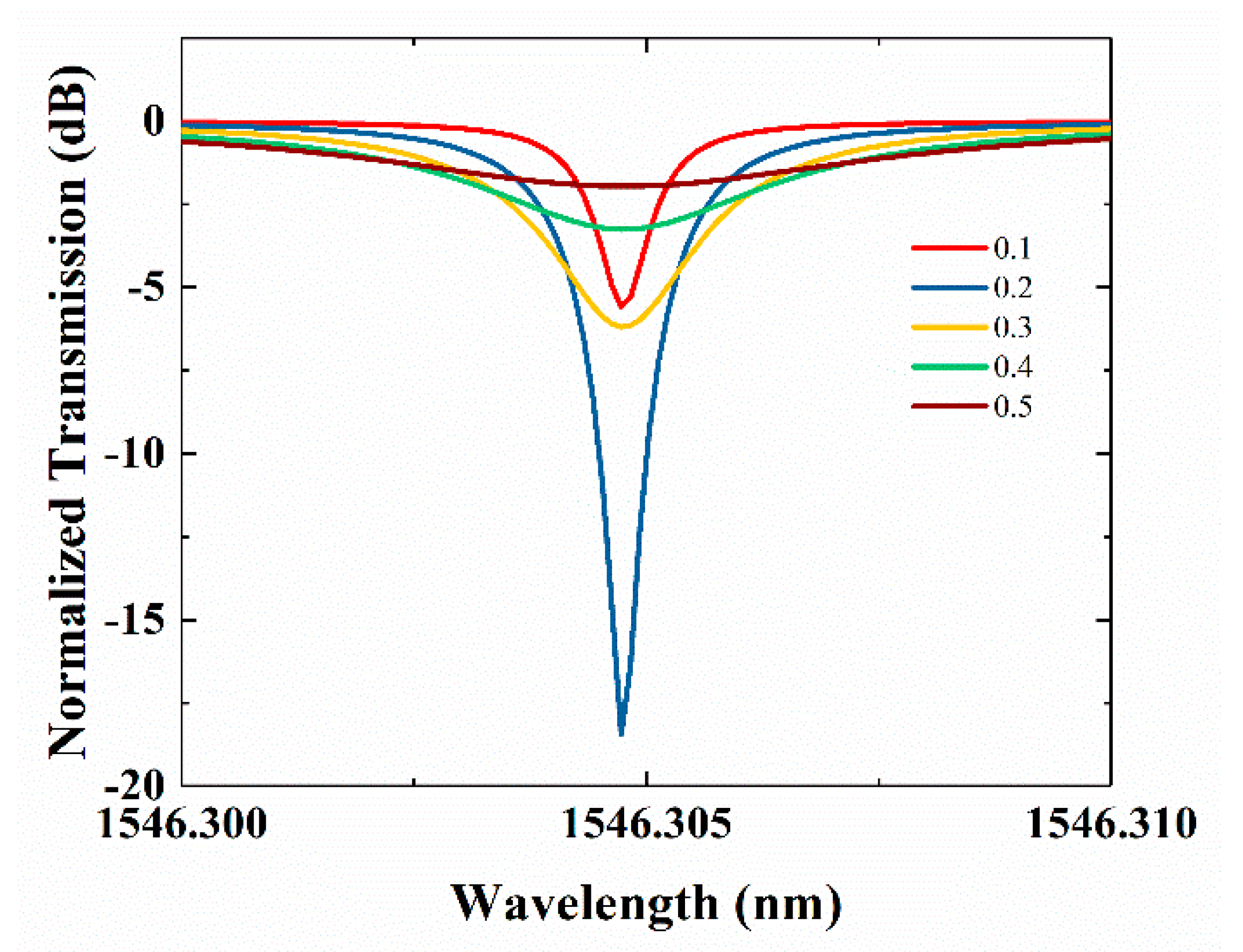
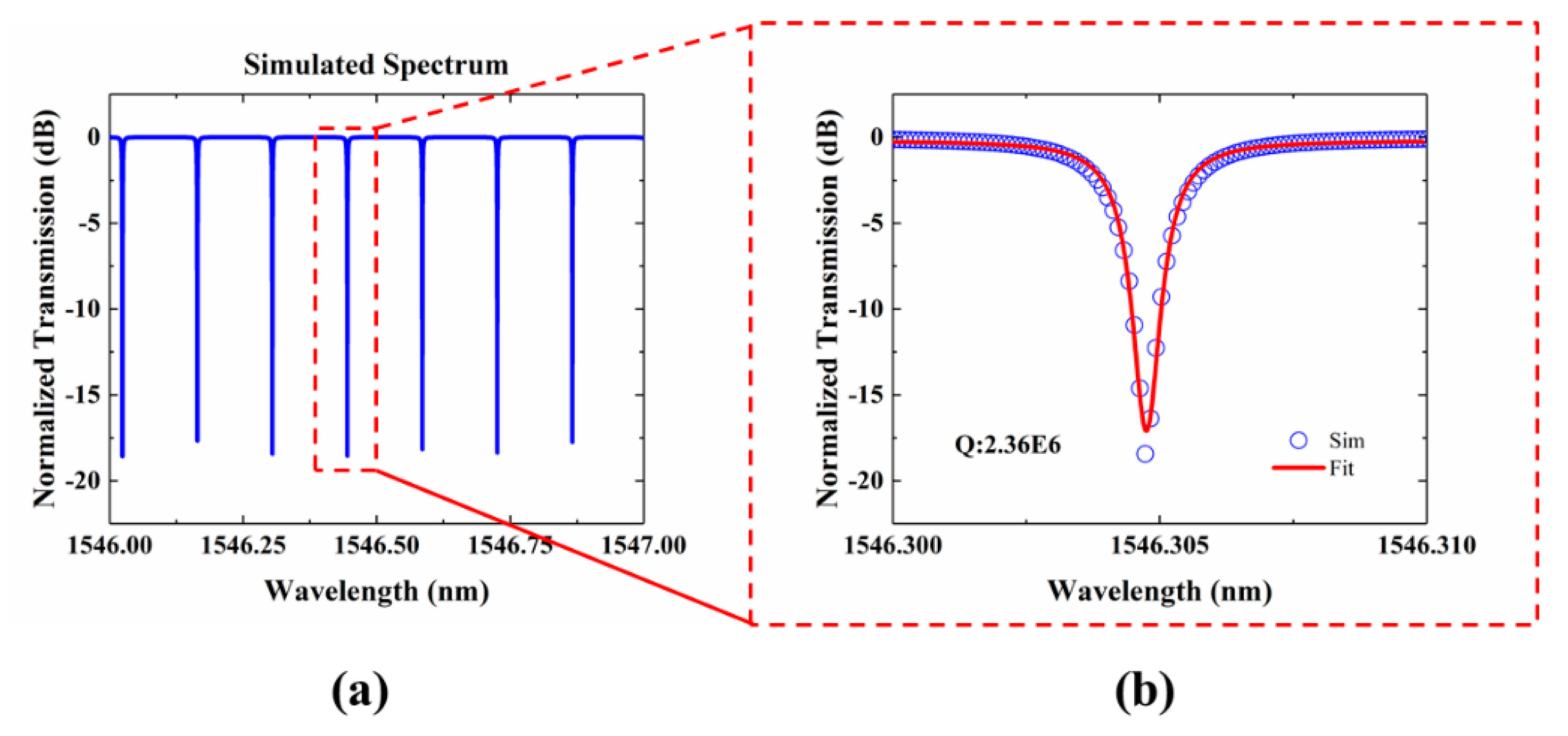

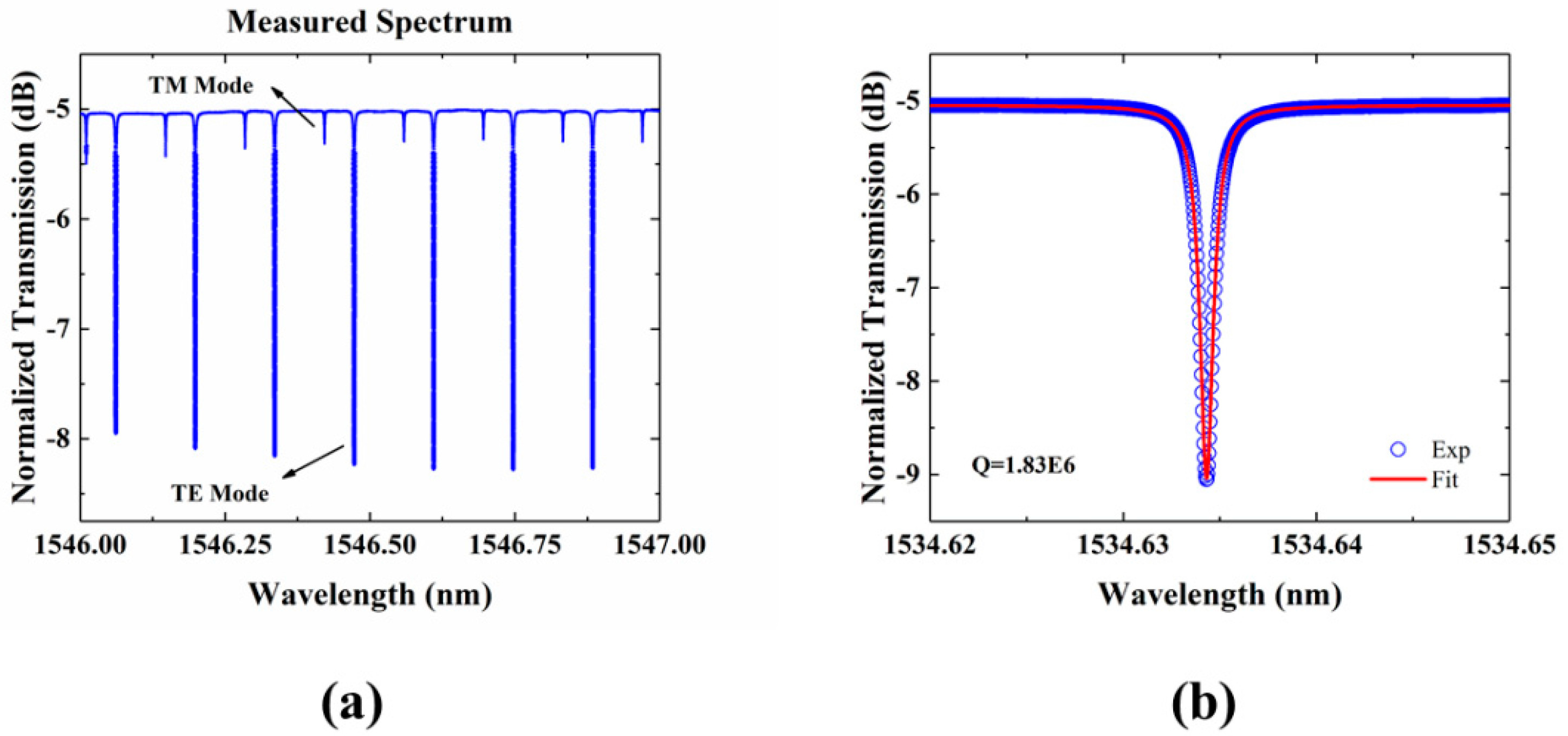
| Ref. | Platform | R (μm) | FSR (nm) | Q-Factor |
|---|---|---|---|---|
| [32] | silicon | 50 | N.A. | 7.60 × 105 |
| [34] | silicon | 29 | 0.900 | 1.30 × 106 |
| [35] | silicon | 6000 | 0.017 | 1.70 × 106 |
| [33] | SiN | 115 | N.A. | 3.70 × 107 |
| [21] | Polymer planar lightwave circuits (PLC) | 60 | 2 | 8.00 × 105 |
| [20] | Microtube/SOI | 3.5 | 3~33 | 1.5 × 105 |
| This Work | Silica PLC | 1600 | 0.137 | 1.83 × 106 |
Publisher’s Note: MDPI stays neutral with regard to jurisdictional claims in published maps and institutional affiliations. |
© 2021 by the authors. Licensee MDPI, Basel, Switzerland. This article is an open access article distributed under the terms and conditions of the Creative Commons Attribution (CC BY) license (http://creativecommons.org/licenses/by/4.0/).
Share and Cite
Yin, Y.-X.; Yin, X.-J.; Zhang, X.-P.; Yan, G.-W.; Wang, Y.; Wu, Y.-D.; An, J.-M.; Wang, L.-L.; Zhang, D.-M. High-Q-Factor Silica-Based Racetrack Microring Resonators. Photonics 2021, 8, 43. https://doi.org/10.3390/photonics8020043
Yin Y-X, Yin X-J, Zhang X-P, Yan G-W, Wang Y, Wu Y-D, An J-M, Wang L-L, Zhang D-M. High-Q-Factor Silica-Based Racetrack Microring Resonators. Photonics. 2021; 8(2):43. https://doi.org/10.3390/photonics8020043
Chicago/Turabian StyleYin, Yue-Xin, Xiao-Jie Yin, Xiao-Pei Zhang, Guan-Wen Yan, Yue Wang, Yuan-Da Wu, Jun-Ming An, Liang-Liang Wang, and Da-Ming Zhang. 2021. "High-Q-Factor Silica-Based Racetrack Microring Resonators" Photonics 8, no. 2: 43. https://doi.org/10.3390/photonics8020043
APA StyleYin, Y.-X., Yin, X.-J., Zhang, X.-P., Yan, G.-W., Wang, Y., Wu, Y.-D., An, J.-M., Wang, L.-L., & Zhang, D.-M. (2021). High-Q-Factor Silica-Based Racetrack Microring Resonators. Photonics, 8(2), 43. https://doi.org/10.3390/photonics8020043





